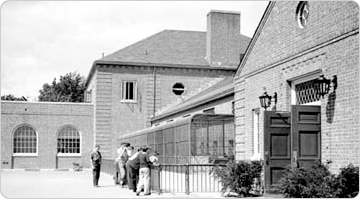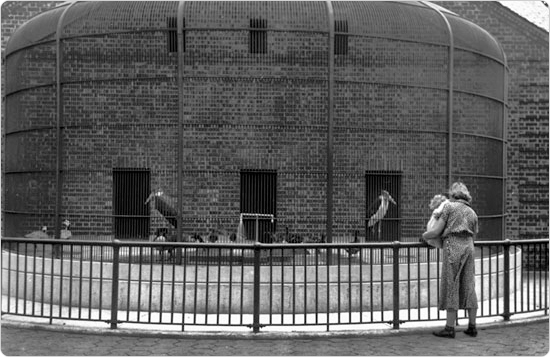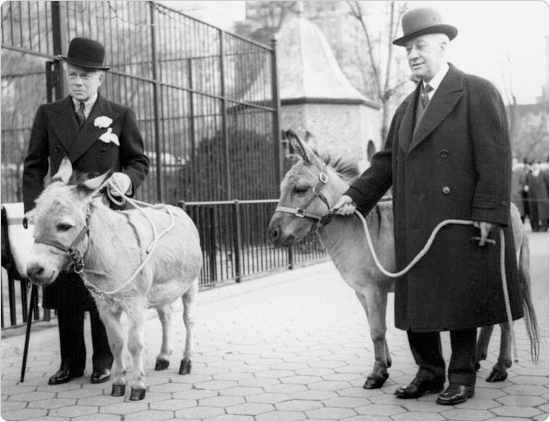History of the Staten Island Zoo
The Staten Island Zoo got its start when Barrett Park was acquired in 1930 after Julia Hardin (d. 1930), a relation of park namesake Clarence T. Barrett (a major in the Civil War and Staten Island civic leader), willed property she owned to the City. The property was given upon condition that the site would not be used as a playground, that it would be named for Barrett, and that Hardin's husband was allowed to live in the house on the property while he was still alive. Upon Mr. Hardin's death, the City took over the property and the Staten Island Institute for Arts and Sciences began planning for a zoo, creating an organization called the Staten Island Zoological Society in August 1933 to curate exhibits there.
When construction began in 1933-34, the zoo's plans were state of the art. Parks used New Deal-era Civilian Conservation Corps labor to help build the $150,000 facility. The exhibits and the zoo's care for its animals were modern for their time and helped the institution avoid some of the trouble other city zoos faced when their facilities became out of date. The Staten Island Zoological Society was devoted early on to its educational mandate, and the Society's objectives have been the same since the zoo's opening: to disseminate a knowledge of zoology and an appreciation of animal life; to maintain animals for observation and study; to instill an understanding and appreciation of creatures; to provide lectures and facilities for the study of natural history.
The earliest animals to inhabit the zoo were housed in a barn on the site during construction of the facility, which opened on June 10, 1936. But since its opening in 1936, the Staten Island Zoo has been best known for its snakes. The zoo's Serpentarium is the only one in the country to feature all 32 species of rattlesnakes. The zoo claims the first Aruba Island snake and ridge-nosed rattlesnake ever exhibited, as well as the first Southwestern Speckled rattlesnake ever bred in captivity. The zoo's reptilian preeminence led it to sponsor the first International Snake Exhibit, held in Grand Central Palace in 1936. The zoo's focus on snakes is due in part to Carl Frederick Kauffeld, the former Curator of Reptiles. Early zoo figures Harold J. O?Connell, the organizer of the Staten Island Zoological Society, and Carol Stryker, the zoo's first director, were also big reptile proponents.
Former Governor Al Smith, a big fan of zoos, also presided over the Staten Island Zoo's opening, and said that he hoped the Zoological Society could expand its domain to provide for larger animals: “I'm not particularly attracted to snakes,” he was quoted by the New York Times, “My early admiration for St. Patrick in large part was due to the fact that, according to history as I was taught, he banished them out of Ireland.” The “night custodian” of Central Park added, “Some night when it's quiet and deserted up there at Central Park, I may go over and pick up a coupla lions for you.”
Other animal donations came from John Jacob Astor's great-great-grandson Vincent Astor, who donated a host of animals from the Galapagos Islands, and Mayor Fiorello H. LaGuardia, who lent two Solenodons, a rat-like insectivore native to the West Indies (itself a gift to him from the infamous Dominican Republic dictator Rafael Trujillo). The Staten Island Zoo is also notable for being the first American zoo to have a full-time female veterinarian on staff, Dr. Patricia O?Connor, who was hired in 1942 as the zoo's vet.
The zoo had its first major renovation in 1969 when a Children's Center was constructed using considerable input from a focus group of children. Further renovations took place in 1984, and in 1988 the zoo received accreditation by the American Association of Zoological Parks and Aquariums. Always sensitive to the care of the animals, the zoo's goal will continue to be providing naturalistic settings for the animals on display. Tropical forest and African savannah exhibits were installed in the 1990s, and a Tudor-style house was acquired for educational programs and to house the administrative staff of the zoo.


